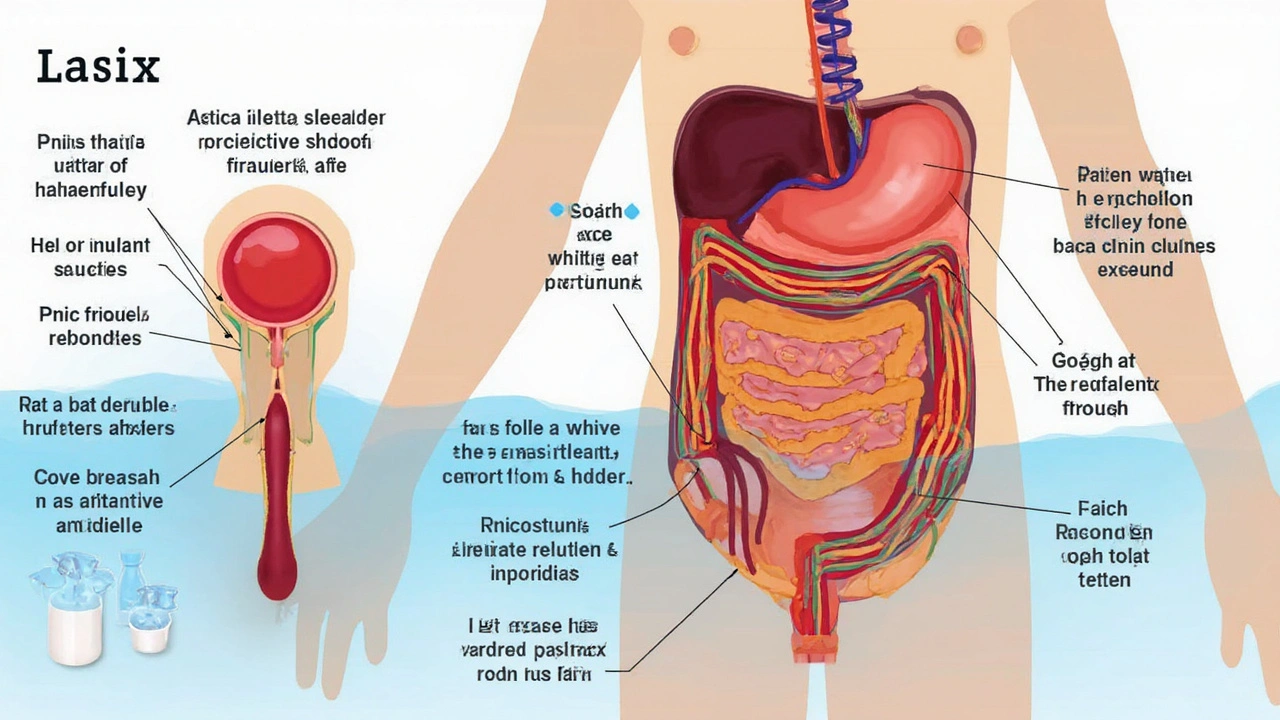
It’s wild how something as basic as water balance in your body can change the way you look, feel, and even live. That’s what makes Lasix (furosemide) such a go-to in hospitals and medicine cabinets. One tiny pill, and—poof—your body’s clinging onto less fluid, your swollen ankles shrink, and your lungs stop drowning in their own secretions. Sounds like a miracle fix, right? But, as always with miracles, there’s more to the story than meets the eye. Lasix isn’t just a magic “water pill.” There’s history, science, controversy, and a bunch of everyday advice you won’t find stuffed inside a pharmacy pamphlet.
How Lasix Works—And Why Bodies Need It
If I said Lasix’s job is to make you pee, that’d be technically true but kind of misses the whole superpower angle. Here’s the scoop: Lasix is in the diuretic family, specifically called a ‘loop diuretic,’ and works mostly by acting on your kidneys. Its claim to fame is that it makes your kidneys dump a much larger amount of salt (sodium) and water into your urine than they’d normally manage on their own. And when that water goes out, it doesn’t just trim off pounds on the bathroom scale—it takes pressure off your heart, blood vessels, and anywhere else your body’s stashing unwanted fluid.
Doctors usually pull out Lasix when someone is swollen because their heart, kidneys, or liver aren’t working well. Ever seen the classic images of swollen feet in older folks, or people carrying tennis-ball bellies full of fluid? That’s edema, and it’s often the reason a doc scribbles ‘furosemide’ on a prescription pad. Lasix can work so fast that some heart failure patients jokingly refer to it as their "bathroom alert"—they know to never leave home without a plan. It’s also a lifesaver in hospitals when lungs fill up with fluid (pulmonary edema), and a backup quarterback when blood pressure just won’t behave.
But the thing that really blows the mind? Lasix’s real “target” is a part of your kidney called the loop of Henle—tiny, twisty tubes inside every kidney, busily filtering your blood minute by minute. By blocking a protein pump here, Lasix keeps sodium and chloride from being reabsorbed back into your body. Salt drags water with it, so you pee both out. A strong dose can prompt several liters of fluid loss in hours. That’s why Lasix is so potent yet so easy to misuse if you don’t know what you’re doing.
Did you know that Lasix’s nickname “loop diuretic” isn’t just for trivia night? It's because there are other kinds of water pills, like thiazides and potassium-sparing diuretics, each working in different places in the kidney. But Lasix reigns as one of the strongest, and most addictive (psychologically, anyway) diuretics on the menu. And get this—furosemide was invented back in the swinging ‘60s, and hasn’t left the stage since. Its discoverers didn’t realize just how much this humble pill would change fluid management for millions of people worldwide.

The Good, The Bad, and The Misunderstood: Risks and Side Effects
So, there’s the obvious benefit from Lasix: you get rid of excess fluid, you can breathe easier, your rings fit again. But, like any hero with a mysterious past, there are downsides hidden in the fine print.
The big headline? Lasix can make your body too good at ditching water and salts. When you lose too much potassium (hello, banana cravings), that’s when things can go off-script. Low potassium isn’t just about leg cramps—it’s notorious for triggering dangerous heart rhythms. Doctors often balance Lasix with another pill “potassium supplement,” or they’ll keep checking your bloodwork like helicopter parents. Sometimes you’ll see people prescribed potassium-sparing diuretics alongside Lasix—kind of like a checks-and-balances system for your kidneys.
On top of that, Lasix can flush out not just potassium, but also magnesium, calcium, and sodium. You might feel dizzy, weak, or notice a headache if your blood pressure falls too far—especially when standing up fast. Some unlucky folks even end up dehydrated if they overdo it, leading to kidney injury or, in extreme cases, fainting spells (trust me, passing out in a grocery store is nobody’s idea of a party). If you take Lasix and feel really parched, woozy, or can’t stop peeing, that’s your body trying to wave the red flag.
Ever wonder why some athletes and bodybuilders used to reach for Lasix before competitions? It’s because it gives that “dry,” defined look by scraping off extra water weight—just an illusion of leanness. It’s illegal in most sports for exactly this reason, and it can be really risky to use this way (there’ve been tragic stories of people collapsing from severe electrolyte imbalances right backstage).
Lasix also has some “quirky” side effects. A lot of people complain about temporary hearing problems—ringing in the ears, or even losing their hearing when doses are too high or given too quickly through an IV. Doctors call this “ototoxicity,” and trust me, no one wants to win that scratch-off ticket. Reactions like allergies (rashes, itching) can pop up—especially if you’re sensitive to sulfa drugs, since Lasix shares a family tree with them.
Let’s not forget the whole ‘timing your day around the bathroom’ thing. Planning errands, commutes, movie nights—Lasix throws a wrench in all of it. You can go from feeling fine to eyeing every public restroom in a six-block radius within the hour. If you’re taking it, you quickly learn every trick in the timing book—never pop your pill right before a work meeting, for starters.
Key takeaway: Lasix (or any diuretic) isn’t a “take more, get better faster” kind of deal. Skipping potassium checks, mixing with certain foods, or messing around with salt and water intake can turn an ordinary day into a medical emergency. Every “miracle fix” has its kryptonite, and Lasix is no exception.

The Everyday Truth: Tips, Monitoring, and Real-Life Stories
If there’s a thread running through the Lasix story, it’s that taking the pill is only half the journey. What you do around your doses, how you eat, and the small bits of advice nobody really mentions—they all matter way more than you’d expect.
First, food. Salt is Lasix’s arch-nemesis. If you keep eating super salty food, your body just holds onto more water, forcing your doctor to up the dose (which, you guessed it, increases risk of side effects). Takeout, canned soup, even “healthy” veggie juices can sneak in buckets of sodium. I always tell people to become a label detective. Learn which foods blow up fluid retention. If you’re craving flavor but need to go easy on the salt, try fresh herbs, citrus, or chili flakes – your taste buds (and ankles) will thank you.
Staying hydrated is actually a balancing act. Hang on, you might say, isn’t this pill supposed to get rid of water? True, but you still need enough fluids to keep your kidneys happy—and avoid those “I think I’m going to pass out” moments. The best trick? Check your pee. Dark yellow? Probably need more water. Completely clear or running to the bathroom every 30 minutes? Dial it down.
One of the best tips is to keep a daily log—even if it's just a calendar note. Jot down your weight each morning (same time, same clothes, or lack thereof). If you spot a few pounds sticking on or coming off quickly, it can be the first clue something’s changing in your body, sometimes even before you notice symptoms. A lot of doctors ask you to call if you gain or lose more than 2-3 pounds in a day or 5 pounds in a week. It seems nit-picky, but they’re trying to spot warning signs before things get bad.
Here’s a real slice of life: A friend’s mom in my old Portland neighborhood used to say she planned her day like a military drill around her “Lasix hour.” She’d take the pill, put a little bell on the cat (who would yowl every time she headed to the bathroom), and start her “hydration challenge.” By coordinating errands around the effect, she managed to keep her independence and avoid embarrassing moments. It’s this kind of lived wisdom nobody tells you in med school, but it makes a world of difference.
If your doctor checks your blood regularly (think potassium, magnesium, and kidney function), that’s not them being fussy—it’s essential. Some people with kidney problems or diabetes (or those taking medicines for gout, blood pressure, or mood disorders) need even closer checks. If you’re seeing a new symptom, like muscle twinges, confusion, or your heart skipping beats, don’t brush it off – it could mean your electrolytes are out of whack.
Pay attention to drug interactions. Nonsteroidal anti-inflammatory drugs (NSAIDs) like ibuprofen, some antibiotic classes, or certain antidepressants can either reduce the effect of lasix or seriously ramp up risks. Make every doctor or pharmacist aware you’re taking it—sometimes even a routine over-the-counter pick can go sideways when diuretics are in the mix.
And if you’re pregnant, breastfeeding, or have a history of gout or allergy to sulfa drugs, bring it up right away—Lasix might not play nicely with those conditions. Dosage for kids or older adults often looks totally different, because their bodies hang onto (or lose) water and salts in unpredictable ways.
People sometimes expect an instant “fix” with Lasix, but managing chronic fluid overload is more like a marathon—it takes teamwork, a sense of humor, and a willingness to tinker with routines based on how you feel each week. Connecting with others in support groups, especially online, is gold for picking up real-life pointers, like the sneaky effects of weather, travel, or even altitude (Lasix can make you extra-sensitive to dehydration at higher elevations!).
A hidden tip: Track your cravings and your mood. Some folks notice weird food urges or feel off emotionally when their salt or potassium dips too low. That’s your brain’s way of nudging you—don’t ignore it. And if your doctor ever tells you to stop Lasix suddenly, or double up without bloodwork, ask questions. Sometimes, a little pushback is the best defense against medical mix-ups.
Lasix is powerful, older than most of the folks who take it, and—if you know how to work with it rather than against it—can actually feel like a life-restoring fix. It’s never boring, that’s for sure.





Comments (11)
Sandy Gold
Honestly, people have no clue how precarious Lasix really is. It's not just a magic pill to flush out water. The mechanisms behind it? Complex as heck, and the article barely scratches the surface.
Sure, it’s effective for fluid retention but have you ever pondered the electrolyte imbalances it creates? Like, potassium levels dropping dangerously low! Doctors often overlook that subtlety and patients get left in the dark.
Also, let’s not forget how overprescribed it gets in some circles—some clinicians use it as a bandaid rather than addressing root causes. It’s kinda frustrating when you think about it.
Seriously, if someone’s using Lasix daily, they should be monitored closely, not just handed a script. I’ve seen firsthand what happens when it’s mismanaged: fatigue, cramps, and worse.
Anyone else feel like we always need a deeper dive on stuff like this? The average patient should understand these nuances rather than just blindly trusting the label.
Frank Pennetti
Cut the fluff. Lasix is a furosemide diuretic, end of story. It’s the choice drug for edema and hypertension because it targets the Na-K-2Cl symporter in the thick ascending limb of the loop of Henle, leading to potent diuresis. No need to romanticize it.
But here’s the problem: people misuse it for weight loss or scientific gymnastics with electrolytes and renal perfusion. Ignorance mixed with misinformation leads to misuse, which then causes hospital admissions for hypokalemia or even ototoxicity.
The author seems to dance around the risks without really drilling into pharmacokinetics, which frankly makes the entire 'power and pitfalls' theme a miss.
If you want my two cents, anyone dispensing or prescribing Lasix needs to be armed with data, not headlines.
So yeah, stop sensationalizing what is a tightly controlled therapeutic tool. Science, not dramatics, please.
Keri Henderson
I think it's important to remember why doctors prescribe Lasix in the first place. Yes, there are risks, but when used properly, it can truly improve quality of life for people with heart failure or kidney issues.
The article does a decent job outlining what to watch for – monitoring electrolytes, staying hydrated, and reporting symptoms early. These are critical steps to prevent complications.
For anyone on Lasix, working closely with your healthcare provider is essential. Don’t stop or change doses without consulting them. It’s about empowerment through knowledge and communication.
I’ve coached a few patients through this, and the ones who stay informed fare much better. It’s all about respecting the drug’s power and treating it with care.
So yeah, not all risk is equal. Lasix is powerful, but with the right approach, it’s manageable.
elvin casimir
Okay, first off: 'impact on the body'? Seriously, how lazy can one be? This article is rife with oversimplifications and borderline buzzwords.
Lasix is not some casual medication; it’s a pharmacological heavyweight with systemic implications. Anyone writing about it should at least spell-check 'furosemide' right – it’s in the title, and yet people butcher it all the time.
Missed opportunity here to discuss dosing intricacies and renal function assessments which, you know, are crucial for safe administration.
Also, let’s keep grammar consistent. The casual tone does no favors when explaining such an important drug.
Bottom line: if you want to write about Lasix, do your homework, or don’t write at all.
Steve Batancs
From a medical standpoint, the article encapsulates the essential information well, but I feel it underplays the responsibility on clinicians to enforce strict monitoring protocols.
Lasix, while a cornerstone drug in treating hypertension and fluid overload, must be dosed according to rigorous guidelines. Self-medication or misuse can lead to disastrous outcomes, especially in elderly demographics prone to electrolyte imbalances.
The piece could further emphasize the pharmacodynamics and necessity for periodic renal and hepatic panels during prolonged use.
Ultimately, education pertains not only to patients but also to prescribers to guarantee safe outcomes and minimize systemic errors.
In summary, let's advocate for structured stewardship of such potent diuretics.
Ragha Vema
Guys, don’t you see? Lasix is just a gateway! The powers that be want us hooked on these meds so we depend on Big Pharma forever. This article conveniently ignores the shadowy interests pushing for mass prescriptions.
Fluid retention? High blood pressure? Convenient labels to justify lifelong drug consumption while real cures are suppressed.
I bet there’s more to the story they don’t want you to know. Side effects? They bury those deep, and you only hear about them after damage is done.
Wake up! Read between the lines—there’s a hidden agenda to keep us medicated and compliant, draining money and health simultaneously.
Is anyone else paranoid here or is it just me?
Scott Mcquain
Well, I appreciate the balance in the article, yet I can’t help but feel we sometimes ignore the moral obligation to use medications judiciously.
Lasix’s benefits do not override the imperative to avoid unnecessary prescriptions. Rational prescribing is not just a clinical decision but an ethical imperative.
Those who manufacture and prescribe these drugs must ensure they do not enable dependency or expose patients to harm needlessly.
Moreover, patients should have a candid dialogue about risks versus benefits rather than a one-sided glorification of effects.
Let's uphold high standards in medication stewardship—it's the least we owe to society.
kuldeep singh sandhu
Just to throw in a different perspective: in India, furosemide is widely available, and uses vary significantly here compared to the US.
People sometimes resort to self-medication with it, mostly due to easier OTC access, which raises different safety concerns.
The article’s safety cautions are vital but may not translate effectively in countries with different healthcare frameworks.
Perhaps global discussions on Lasix usage should address these disparities to ensure safer community practices everywhere.
Still, the pharmacological effects remain consistent, making education universal, albeit with local nuances.
Mariah Dietzler
Honestly, I found the article sort of basic. The side effects mentioned are the usual stuff everyone knows already.
Would have liked a bit more depth on long-term impacts or recent studies about Lasix variants or formulations.
Also, the tips for safer use were kinda generic — like, 'stay hydrated'? Yeah, duh.
Still, I guess for people new to Lasix, it's a decent start. But seasoned folks might feel underwhelmed.
Anyone else feel like these articles just skim the surface for clicks?
Nicola Strand
While I appreciate the effort, the general tone struck me as rather too casual for a topic of such clinical importance.
It is essential to stress quality evidence and clear guidelines over anecdotal 'real-world insights' which may confuse rather than educate.
Moreover, the article lacks depth regarding contraindications and drug interactions, critical in clinical decision-making.
I would advise anyone interested to consult peer-reviewed literature or official medical sources to deepen understanding.
Being a contrarian, I do believe popular articles like this sometimes do more harm by mixing layman tips with medical advice without clear distinctions.
Jackie Zheng
Reading about Lasix always makes me reflect on how drugs act as double-edged swords. They can save lives but require respect and careful management.
What I appreciated is the article's mention of watching out for side effects — often overlooked in casual conversations.
The nuances of electrolyte balance and how the body reacts are so fascinating. Like, how a tiny shift can mean the difference between feeling fine or facing arrhythmias.
That said, pharmacology isn’t just science; there’s a human side too. Patient education must go beyond prescriptions to narratives that empower.
I would love to see more articles connect this scientific with the philosophical, helping people truly understand their meds.